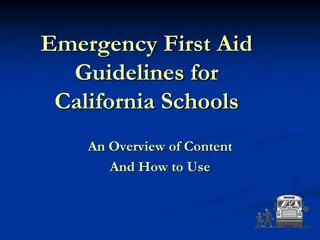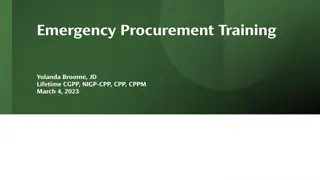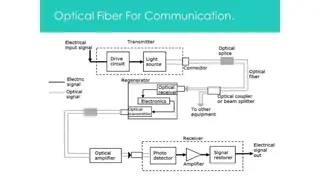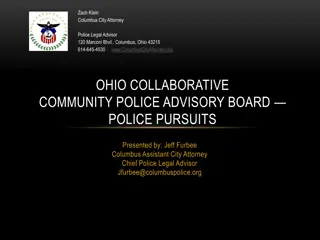School Emergency Action Signals and Procedures
Learn about the different emergency action signals such as Soft Lockdown, Hard Lockdown, Active Threat/Shooter, Stop, Drop, or Cover, Leave the Building, and All Clear. Understand what each signal means and what actions you should take to ensure the safety of the school site and students. Explore the responsibilities of staff members during Soft Lockdown and Hard Lockdown situations. Be prepared to respond effectively in emergency scenarios for the well-being of all stakeholders involved.
Download Presentation

Please find below an Image/Link to download the presentation.
The content on the website is provided AS IS for your information and personal use only. It may not be sold, licensed, or shared on other websites without obtaining consent from the author.If you encounter any issues during the download, it is possible that the publisher has removed the file from their server.
You are allowed to download the files provided on this website for personal or commercial use, subject to the condition that they are used lawfully. All files are the property of their respective owners.
The content on the website is provided AS IS for your information and personal use only. It may not be sold, licensed, or shared on other websites without obtaining consent from the author.
E N D
Presentation Transcript
Emergency Planning Objective: Learn the different emergency action signals Learn what to do during each action Learn your role in making sure the school site and students are safe
6 types of emergency actions 1. Soft Lockdown (danger outside of school) 2. Hard Lockdown (danger on campus) 3. Active threat/shooter (threat/shooter on campus) 4. Stop, Drop or Cover (earthquake, explosion, weapons, etc.) 5. Leave the building (fire, earthquake, etc.) 6. All Clear (resume activity)
Emergency Announcements Soft Lockdown Recommended announcement Your attention please: we are now on a soft lockdown, repeat, we are now on soft lockdown Hard Lockdown Recommended announcement Your attention please: we are now on hard lockdown, repeat, we are now on hard lockdown. Active threat/shooter Recommended announcement We have an active threat/shooter on the premises; repeat we have an active threat/shooter on the premise. Stop, Drop or Cover (earthquake, explosion, weapons, etc.) 1. 2. 3. 4. Verbal command drop Evacuate the building (fire, earthquake, etc.) 5. Recommended announcement Your attention please: please evacuate the building; repeat, please evacuate the building. All Clear Recommended announcement This is First Last Name we are all clear, repeat all clear. 6.
Soft Lockdown What is it? A precautionary security measure primarily used for threats outside the school grounds, but no immediate threat to student or staff. Examples: Police serving a search warrant in area. General threats made to the school which has not been substantiated.
Soft Lockdown Staff Responsibility Confirm receipt of announcement Proceed to your classroom or MPR Doors and gates are locked Blinds closed Contact facilitator with status of students. Ex. Red groups all 16 students secured Student continue with their normal activities, but will not be allowed to participate in any of the outside activities. May upgrade to a hard lockdown at anytime. Bathroom trips may occur on an emergency basis Door may be open for administration and facilitator.
Hard Lockdown What is it? A precautionary security measure primarily used for an immediate safety threat to student or staff. Examples: Drive by shooting in the immediate area Suspicious trespasser on school grounds. Bomb Threat Nearby police activity of a violent nature which may spread to the school
Hard Lockdown Staff Responsibility Confirm receipt of announcement Proceed to the nearest safe location Student to remain quiet Lock Doors Close Blinds Turn off lights Silence cell phones (turn off vibrate) Student spread out away from any windows (not visable) Take attendance Contact facilitator with status of students. Ex. Red groups all 16 students secured Door are not to be opened. Do not evacuate if the fire alarm is activated unless instructed by an administrator.
Active Threat What is it? Active threat/active shooter incidents are rare, but have major consequences to school safety. An active threat/shooter is an individual actively engaged in killing or attempting to kill people in a confined and populated area.
Active Threat Staff Responsibility Run Know your surrounding have escape route and plan in mind Run immediately leave your belongings behind Help others escape Prevent others from entering area where the active shooter may be. Keep your hands visible Call 911 when you are safe
Run Hide Fight Hide If you can t escape, hide in an area out of the shooter s view Lock the door and block the entry to your hiding place Close window and blinds Barricade Doors Silence cell phone (including vibrate mode) and remain quiet. Take cover behind furniture and fixtures away for doors and windows. If hiding in MPR do not hide under tables.
Run Hide Fight Fight Fight as a last resort and only when your life is in imminent danger. Use item around you as weapons to fight Attempt to incapacitate the shooter Commit to your actions your life depends on it
Stop, Drop or Cover What is it? Strategy to protect oneself from falling objects or flying projectiles. Examples: Earthquakes Explosions Gun Shots
Stop, Drop or Cover Staff Procedures During earthquakes or explosions DROP to the ground (before the earthquake drops you!), COVER your head and neck with your arms and seek shelter by getting under a sturdy desk or table if nearby; HOLD ON to your shelter and be prepared to move with it until the shaking stops. If there is no table or desk near you, drop to the ground and then if possible move to an inside corner of the room. Be in a crawling position to protect your vital organs and be ready to move if necessary, and cover your head and neck with your hands and arms.
Stop, Drop or Cover Staff Procedures (cont.) If hear gunshots: Drop to the ground laying flat on your stomach. Listen move away from the gunfire Seek cover Access the situation Call 911
Leave the Building What is it? The process of leaving the building and moving to a designated meeting location. Examples: Fire Gas leak
Leave the building Staff Responsibility Confirm receipt of leave the building announcement Use attention getter to get student attention. Have student line up Walk to designated meeting place Take attendance Contact facilitator regarding status Blue group all 15 student accounted Wait for all clear
All Clear What is it? Signal that denotes that you are safe to return to your regular activity.
How to be prepared Practice drills. Having a current roster. Updated with added students from other groups Have doors locked when in classroom Only staff should open doors Always know the number of students with you All students are supervised You have set attention getters and you are able to get students attention in an instant. Be observant of open classrooms and any suspicious activity
Group roles Incident Leader Police and Fire Liaison Student Accounting Coordinator Staff Assignment Coordinator Site Safety and Security Coordinator Emergency Drill/Tabletop Exercise Coordinator Central Communication Recorder
Where do we go from here. This week: Take campus tour. Learn on campus and off campus evacuation locations Notice all access points to MPR Discover potential safety areas Gas turn off location During the first two week of school Develop/practice attention getters Teach/Review the different safety procedures with your group Conduct site safety drill First drill - Soft Lockdown on August 19th. Ongoing training with students Practice attention getters Review the different safety procedures with your group Monthly When returning from break Conduct site safety drill























